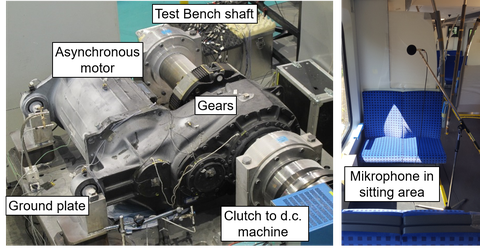Structure-Borne Sound in Rail Vehicles
Table of contents
| Project | Development of a Tool to Evaluate Structure-Borne Sound in Rail Vehicles |
| Editor | Dipl. Ing. Sascha Noack |
| Period |
since01.01.2019 |
| Sponsor | Bombardier Transportation |
Motivation

Sound transmission paths in rail vehicle
The structure-borne sound coming from the drive system defines especially for transient train manoeuvres the experienced interior noise of modern railway traction vehicles. Therefore, a deeper look at the origin and the transmission of structure-borne sound is of great importance. In a joint research project of the Chair of Dynamics and Mechanism Design and Bombardier Transportation the possibility of modelling the vibration behaviour of an electric multiple unit is investigated up to the acoustic frequency range. In the future applying the developed methods to other trains should help predicting and decreasing the structure-borne sound power passed to the interior of the rail vehicle.
Elastic Multibody Simulation (EMBS) for Structure-Borne Sound

Eigenmode of the elastic boogie frame
For analyses of driving dynamics and low-frequency vibrations (0 – 30 Hz) looking at riding comfort of rail vehicles, the method of multibody simulation (MBS) is state-of-the art. Using this method, the vehicle is split in a defined number of rigid bodies, whose degree of freedom to each other and the surroundings is defined by joints. Between these bodies and between bodies and the surroundings force elements can be installed. A big advantage of MBS, for example in comparison to the finite element method (FEM), is the possibility to simulate nonlinear system behaviour in the time domain. To expand the validity to the acoustic frequency range the structural dynamic behaviour of parts taking part in the transmission of structure-borne sound has to be considered by integrating flexible bodies. To reduce the often very large degree of freedom of FE-models of elastic bodies this method uses a modal description of the system and a problem specific selection of eigenmodes. Besides the representation of the deformation behaviour of structure-borne sound transmitting bodies a more detailed modelling with nonlinear spatial force elements and modelling of all relevant excitation mechanisms has to be taken into account.

Example of fluctuating gear stiffness of a helical gear w.r.t. rotation
State-of-the-art modelling of rolling bearings, spherical bearings and dampers in MBS-systems has to be tested in terms of validity in the acoustic frequency range and possibly further developed. Concerning the excitation mechanisms, we have to take a look on the dynamic behaviour of gears. The dynamic excitation results from differing stiffness of the contacting gears with rotation.
Measurement at Motor-Gear Test Bench and Train
Besides simulation of structure-borne sound using the example of the electric multiple unit, measurements at a motor-gear test bench and the train have taken place. Analysing the measurement data, it was discovered that the interior noise is being dominated by parts of the signal below 1000 Hz. Knowing that, the simulated frequency range can be set to 20 – 1000 Hz. Furthermore, the measured sound pressures and accelerations can be used to later validate the simulation models.

Acceleration measurements at test bench and sound pressure meas-urements in a driving train
Goals of the current research project
A first comparison of measurement and simulation data has shown there is room for improvement in modelling the EMBS system of the rail vehicle. By analysing the sensitivity of selected model parameters, the most influential model elements have to be identified and their detail of modelling has to increased. Parts that have to be looked at are gears, driving shaft, rolling bearings, dampers, spherical bearings and the car body. Easy replacement of modelling elements and an easy variation of model complexity can be ensured by implementation of a modular model concept. The implementation in Simpack is done for usage in the Simpack-Wizard which provides additionally an easy to use graphical interface. In the future this interface will help introducing the structure-borne sound simulation using EMBS techniques to the development process at Bombardier Transportation.
